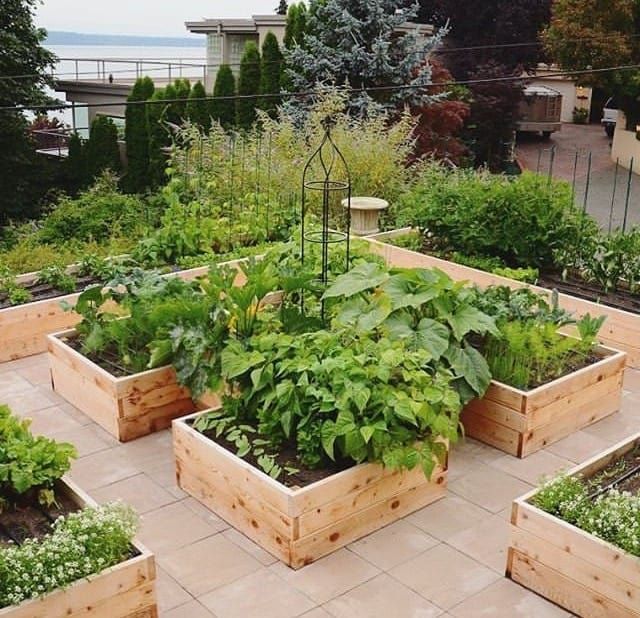Pictures of raised bed vegetable gardens showcase not only the beauty but also the practicality of this gardening method. Raised bed vegetable gardens are an increasingly popular choice for both experienced gardeners and beginners alike. These types of gardens involve planting in beds that are elevated above ground level, offering a range of benefits such as better drainage, improved soil quality, and easier maintenance.
One of the main advantages of raised bed vegetable gardens is the ability to control the soil quality more effectively than in traditional in-ground gardens. By using a specific soil mix tailored to the needs of your plants, you can create optimal growing conditions for vegetables. Additionally, raised beds can warm up faster in the spring, extend the growing season into fall, and prevent soil compaction.
Furthermore, raised bed vegetable gardens are versatile and can be customized to fit any space or aesthetic preference. Whether you have limited space on a balcony or a spacious backyard, you can design and plan your own raised bed garden to suit your needs.
In the following sections, we will provide guidance on how to get started with planning and designing your raised bed vegetable garden, including tips on selecting the right location, building the beds, choosing soil mixtures, planting recommendations, maintenance strategies, seasonal planting guides, and inspirational success stories.
Getting Started
When embarking on the journey of creating a raised bed vegetable garden, it is essential to start with careful planning and thoughtful design. This crucial step sets the foundation for a successful and bountiful gardening experience. To help you kickstart your project, here are some valuable tips on how to plan and design your raised bed vegetable garden.
Assess Your Space
Before diving into the actual design process, take time to evaluate the available space for your raised bed garden. Consider factors such as sunlight exposure, proximity to a water source, and accessibility for maintenance. It’s also important to think about the size of your garden beds and how they will fit within your overall outdoor space.
Design Layout
Next, sketch out a plan for your raised bed vegetable garden layout. Think about whether you want individual beds or a continuous layout, as well as any pathways or access points you may need. Keep in mind the mature size of your chosen vegetables when spacing out the beds, ensuring there is enough room for growth without overcrowding.
Select Materials
When planning your raised bed garden, consider what materials you will use for construction. Common options include wood, metal, or composite materials. Each has its pros and cons in terms of durability, cost, and aesthetic appeal. Choose materials that align with your budget and design preferences while also ensuring they are suitable for holding soil and withstanding weather conditions.
By following these tips on planning and designing your raised bed vegetable garden, you can set yourself up for success in growing healthy and abundant crops. With a well-thought-out layout and careful consideration of the details, you’ll be on your way to creating a thriving garden that not only provides fresh produce but also enhances the beauty of your outdoor space.
Choosing the Right Location
When it comes to choosing the right location for your raised bed vegetable garden, there are several factors to consider in order to ensure the success of your plants. Here are some key considerations to keep in mind:
- Sunlight: One of the most important factors to consider when selecting a spot for your raised bed garden is sunlight. Most vegetables require at least 6-8 hours of direct sunlight each day to thrive. Choose a location that receives ample sunlight throughout the day, preferably facing south or west for optimal exposure.
- Accessibility: Another important factor to consider is accessibility. Make sure that your raised bed vegetable garden is located in an area that is easy to access for planting, watering, weeding, and harvesting. Avoid placing your garden in areas that are difficult to reach or navigate.
- Water Drainage: Proper water drainage is essential for the health of your plants. Avoid low-lying areas that may become waterlogged during heavy rains, as this can lead to root rot and other issues. Ideally, choose a location with well-draining soil or consider adding drainage features to your raised beds.
In addition to these factors, it’s also important to consider any specific needs of the vegetables you plan on growing in your garden. By taking into account these factors when selecting a spot for your raised bed vegetable garden, you can help ensure a successful growing season and bountiful harvest.
Now that you have considered these key factors when selecting a location for your raised bed vegetable garden, you can move on to the next step of actually building the beds. Check out our next section on “Building the Beds” for step-by-step instructions on how to construct raised beds for your vegetables.
Building the Beds
When it comes to creating a successful raised bed vegetable garden, one of the crucial steps is building the beds themselves. Whether you are a seasoned gardener or a beginner, constructing raised beds can make a significant difference in the productivity and efficiency of your garden. Below are step-by-step instructions on how to build raised beds for your vegetables:
1. Gather Materials: Start by collecting all the necessary materials for building your raised beds. This typically includes untreated wood, such as cedar or redwood, which is resistant to rot and chemicals that may seep into your soil.
2. Choose the Size and Shape: Determine the size and shape of your raised beds based on the available space in your garden and your preferences. Popular options include rectangular or square-shaped beds that are 4 feet wide to allow easy access from all sides without stepping on the soil.
3. Construct the Frame: Using screws or nails, assemble the frame of your raised bed by connecting the wooden boards at the corners. Make sure to use a level to ensure that all sides are even and straight.
Once you have successfully built your raised beds, you are one step closer to enjoying a bountiful harvest of fresh vegetables right from your backyard. By following these step-by-step instructions, you can create sturdy raised beds that will provide a supportive environment for your plants to thrive and flourish.
Whether you choose to build simple wooden frames or opt for more elaborate designs, having well-constructed raised beds is essential for successful vegetable gardening. So roll up your sleeves, gather your materials, and start building those raised beds today.
Soil and Planting
Soil is a critical component of any successful raised bed vegetable garden. The right soil mix can make all the difference in the health and productivity of your plants. When it comes to choosing the best soil for your raised beds, a combination of topsoil, compost, and other organic matter is recommended. This mixture provides essential nutrients for your vegetables to thrive.
In addition to the soil mix, selecting the right plants for your raised bed garden is equally important. Consider factors such as the size of your beds, the amount of sunlight they receive, and your climate when deciding what to plant. Some popular choices for raised bed vegetable gardens include tomatoes, peppers, lettuce, carrots, and herbs. Be sure to research each plant’s specific needs in terms of spacing, watering, and sunlight to ensure a successful harvest.
When planting in your raised bed garden, be mindful of proper spacing between plants to allow for adequate growth and airflow. Consider companion planting strategies to maximize space and deter pests naturally. Remember to regularly monitor the health of your plants and adjust your care routine as needed. With the right soil mix and thoughtful selection of plants, you can create a vibrant and fruitful raised bed vegetable garden that will provide you with fresh produce throughout the growing season.
Maintenance
Watering Techniques
Proper watering is crucial for the success of your raised bed vegetable garden. One effective technique is drip irrigation, which delivers water directly to the roots of plants, reducing waste and evaporation. Installing a timer on your drip system can help ensure consistent watering, especially during hot summer months. You can also consider using soaker hoses or a watering wand for more targeted watering.
Fertilizing Strategies
To keep your vegetables healthy and productive, it’s essential to fertilize your raised bed garden regularly. Organic options like compost, aged manure, or organic fertilizer blends are great choices to enrich the soil without harmful chemicals. When applying fertilizer, be sure to follow the instructions on the packaging and avoid over-fertilizing, as it can lead to nutrient imbalances and harm your plants.
Pest Management
Dealing with pests in your raised bed vegetable garden requires a proactive approach. One natural method is companion planting, where certain plants are grown together to repel pests or attract beneficial insects. You can also use physical barriers like row covers or mesh netting to protect your crops from pests. If pest problems persist, consider using organic pesticides as a last resort but always follow the application guidelines carefully to minimize harm to beneficial insects and pollinators.
By implementing these maintenance tips in your raised bed vegetable garden, you can ensure that your plants thrive and produce bountiful harvests throughout the growing season. Remember that gardening is a learning process, so don’t get discouraged by setbacks. With patience and dedication, you will create a beautiful and productive garden full of delicious homegrown vegetables.
Seasonal Planting Guide
When it comes to a successful raised bed vegetable garden, planning your planting schedule according to the seasons is crucial. By carefully selecting what to plant and when to plant them, you can ensure a continuous harvest of fresh produce throughout the year. In this section, we will provide you with some suggestions for what vegetables to plant in each season and offer tips on how to plan your garden for a bountiful harvest.
In the spring, consider planting cool-season vegetables such as lettuce, spinach, peas, and radishes. These vegetables thrive in the cooler temperatures of early spring and can be harvested before the heat of summer sets in. As the weather warms up, you can transition to warm-season crops like tomatoes, peppers, cucumbers, and zucchinis. These vegetables require more sunlight and heat to grow successfully.
During the fall season, you can continue harvesting some warm-season crops while also planting cool-season vegetables for a late season harvest. Vegetables like carrots, kale, broccoli, and Brussels sprouts do well in cooler temperatures and can even withstand light frosts.
By planning your planting schedule accordingly and rotating your crops each season, you can maximize your garden’s productivity and enjoy a diverse selection of fresh produce all year long. For more inspiration on seasonal planting in raised bed vegetable gardens, take a look at some stunning pictures of raised bed gardens showcasing different plants thriving throughout the seasons.
Success Stories
Raised bed vegetable gardens are not only practical and productive but can also be visually appealing. Success stories from gardeners who have implemented this gardening method often showcase impressive pictures of their flourishing plants and bountiful harvests. These real-life examples serve as inspiration for beginners or experienced gardeners looking to elevate their gardening game.
One common theme among these success stories is the versatility of raised bed gardens. With proper planning and design, raised beds can fit into various spaces, whether it be a backyard, balcony, or rooftop.
The pictures of raised bed vegetable gardens exemplify how creativity in layout and plant selection can transform any area into a thriving green space. From small urban gardens to spacious rural landscapes, these visual examples demonstrate that anyone can enjoy the benefits of growing their own food in a raised bed setup.
Furthermore, the pictures of raised bed vegetable gardens often highlight the efficient use of space and resources. By elevating the planting area, gardeners can arrange their crops in a more organized manner, making it easier to access each plant for care and harvesting.
Additionally, the visuals showcase how raised beds help control soil quality, drainage, and weed growth effectively. Seeing these successful examples can motivate aspiring gardeners to take on the challenge of building their own raised bed garden and reaping its rewards.
| Benefit | Example |
|---|---|
| Versatile | Pictures showcasing different types of spaces for raised bed gardens |
| Efficient Use of Resources | Images demonstrating organized planting methods in raised beds |
Conclusion
In conclusion, raised bed vegetable gardens offer a plethora of benefits for both novice and experienced gardeners alike. The ability to control soil quality, manage pests more effectively, and extend the growing season are just a few advantages that make this gardening method so popular. By following the tips provided in this guide and utilizing the resources available, anyone can create a thriving raised bed vegetable garden right in their own backyard.
When considering starting your own raised bed vegetable garden, remember to carefully plan and design your layout, taking into account factors such as sunlight exposure, water accessibility, and plant compatibility. Choosing the right location is crucial for the success of your garden, as it will directly impact the growth and yield of your vegetables. Additionally, building the beds correctly using quality materials will ensure longevity and sustainability for years to come.
As you delve into the world of raised bed vegetable gardening, don’t forget to explore different soil mixes for optimal plant growth and follow a seasonal planting guide to keep your garden productive year-round. Remember that maintenance is key – watering consistently, fertilizing appropriately, and addressing pest issues promptly will help you achieve bountiful harvests.
And if you ever feel overwhelmed or unsure, refer back to success stories from other gardeners who have created beautiful raised bed vegetable gardens – their pictures can serve as inspiration for your own gardening endeavors.
So why wait? Start planning your raised bed vegetable garden today and enjoy the satisfaction of growing your own fresh produce right at home.
Frequently Asked Questions
What Vegetables Should Not Be Grown in a Raised Bed?
Certain vegetables like corn, pumpkins, and watermelon are not ideal for raised beds due to their extensive root systems and space requirements. These plants may not thrive or produce well in the confined space of a raised bed.
What Vegetables Grow Well in Raised Beds?
Vegetables that grow well in raised beds include lettuces, radishes, carrots, tomatoes, peppers, and herbs like basil and parsley. These plants have shallow root systems or do well with the drainage and warmth that raised beds provide.
How Deep Should a Raised Garden Bed Be for Vegetables?
The ideal depth for a raised garden bed for vegetables is around 6 to 12 inches deep. This allows for proper root development while still being manageable for planting and maintenance tasks. Deeper beds can be beneficial for certain crops with deeper roots such as potatoes.

If you’re looking to get into vegetable gardening, or are just looking for some tips on how to make your current garden better, then you’ve come to the right place! My name is Ethel and I have been gardening for years. In this blog, I’m going to share with you some of my best tips on how to create a successful vegetable garden.





